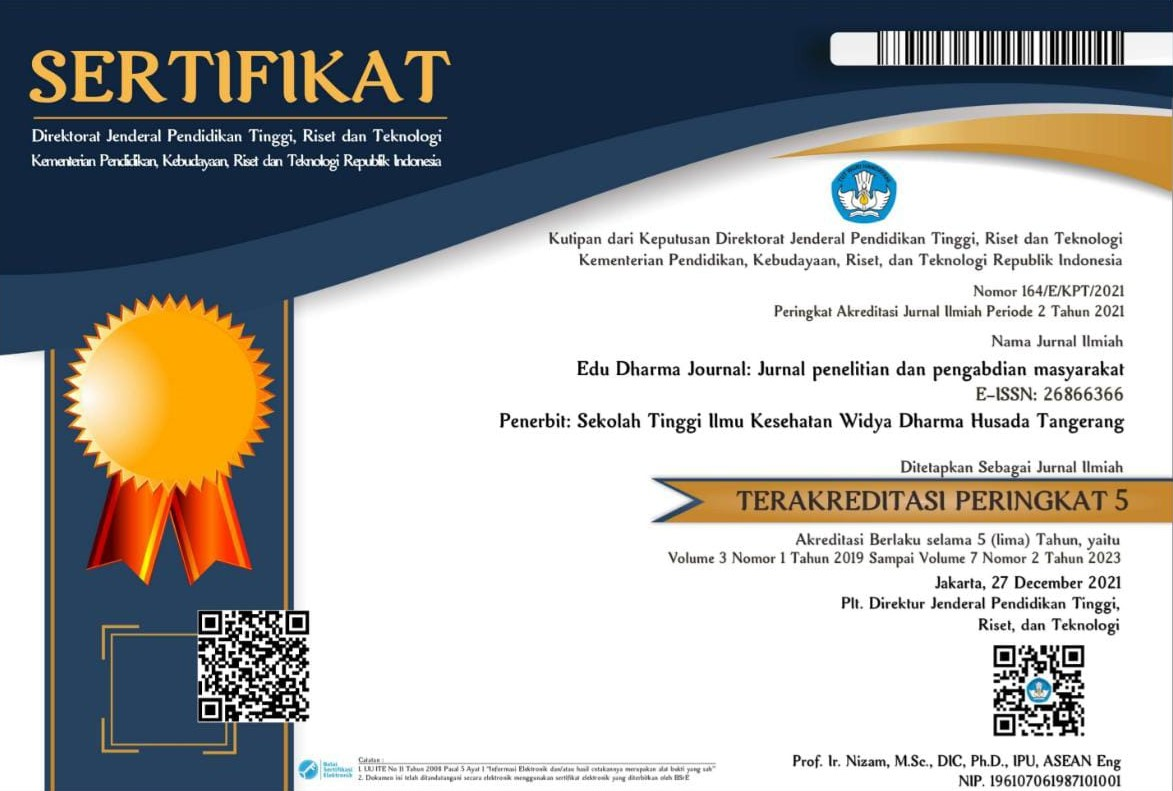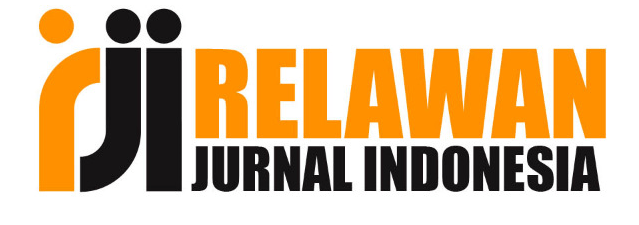Online Submissions
Already have a Username/Password for Edu Dharma Journal: Jurnal penelitian dan pengabdian masyarakat?
Go to Login
Need a Username/Password?
Go to Registration
Registration and login are required to submit items online and to check the status of current submissions.
Author Guidelines
Edu Dharma Journal accepts manuscripts in the form of a research report (Original article research paper) in the field of a public health study that has not been or is being processed for publication in another journal. Manuscripts can use Indonesian and English. Manuscripts sent/submitted in the form of an MS Word file into OJS Edu Dharma Journal: Jurnal Penelitian Dan Pengabdian Masyarakat.
Journal writing guidelines are as follows:
- Manuscripts were written in A4 (two column), with a margin (margin): Top of 2.54 cm, Bottom: 2,54 cm, Left: 2,8 cm, and Right of 2,54 cm, and the letter (font) Times New Roman, large letters (font size) 12 points and spacing 1.5. a maximum of 15 pages in a single article.
- Each page is assigned a number in the sequence, starting from the title page to the last on the bottom right-hand corner.
- Component articles, include article title, author, Abstract (Indonesian and English), Keywords, Introduction, Materials and Methods, Results, Discussion, Conclusions, suggestions, Acknowledgments, References, and Appendices. Template / Format Writing can be downloaded here.
- The title is written in Indonesian and English language word without including a maximum of 10 years. The title should be clear, concise, and interesting.
- Abstract writing a maximum of 250 words in Indonesian and English language using Times New Roman 11 point, spacing 1. The abstract contains an introduction (1-2 sentences), the purpose of the study (first sentence), materials and methods (3-5 sentences), results in research (3-5 sentences), conclusion (one sentence) made in one (1) paragraph.
- Keywords: At least 3 words maximum 5 words (capital letters only in the first keyword, separated by commas, and does not end in a point on the last keyword)
- The introduction contains urgency and background research describing problems with the inverted pyramid method starting from the global, national, and local. Reference lists (literature or relevant research results) by using a number of sources (APA Style) in each sentence after the dot (.) The number of pages in the introduction is as much as 1-1.5 pages written using Times New Roman 12 point (upright) with 1.5 spacing. Each paragraph begins with the words indented into five digits. The final part should be put forward for preliminary research purposes.
- The materials and methods describe the types of research, the location and time of the study, population and sample, sampling techniques, data collection techniques, data analysis, and data presentation. Research using tools and materials needs to write specifications of the equipment and materials used. Qualitative research such as case studies, phenomenology, ethnography, and others, need to add a description of the checking of the validity of the study results. Writing using Times New Roman 11 point (upright) with 1.5 spacing. The paragraph begins with the words that are indented into 5 digits and may not use organizing writing into "sub-heading" in this section. Published in paragraphs 1-2.
- The results describe the characteristics of the subject, univariate, bivariate, and multivariate analysis (if any). This section MUST NOT insert tables and images. Interpretation of the results is made in the form of a narrative, tables and drawings were made separately in the annex. Writing using Times New Roman 11 point (upright) with 1.5 spacing. The paragraph begins with words that are indented into 5 digits and may not use organizing writing into sub-headings for each variable.
- The discussion contains the reasons that explain the results of research and other studies that support and are not in line with the results obtained. NOT ALLOWED to use the same wording as listed in the result and NOT ALLOWED re-read tables and graphs of the results of the analysis. However, the results can be grouped to be interpreted and discussed based on theory and the results of previous research. Writing using Times New Roman 11 point (upright) with 1.5 spacing. The paragraph begins with words that are indented into 5 digits and may not use organizing writing into sub-headings for each variable.
- The conclusion contains a summary of the description of the results and a discussion with reference to the purpose of the research. Advice is based on research findings that have been discussed. Suggestions can refer to practical action, the development of new theories, and/or studies. Writing the conclusions and recommendations on using Times New Roman 11 point (upright) with 1.5 spacing. The paragraph begins with words that are indented into 5 digits and may not use bullets or numbers. Featured in the first paragraph.
- If needed thanks can be given to 1) the parties to provided financial assistance and support, 2) the support of sections and institutions, and 3) the professionals who contributed to the preparation of the report.
- Bibliography APA Style is written according to the rules of writing. All references used in writing in the bibliography be numbered in accordance with the appearance of the article, alphabetically. Include only used and relevant literature. Referral source at least 80% in the form of literature published 10 years. Referral sources in the form of a journal of articles at least 60% of the total bibliography. References used are the primary source in the form of research articles in journals or research reports, books, or articles that are linked from the official source. Articles that have been published in the Edu Dharma Journal: Jurnal Penelitian Dan Pengabdian Masyarakat are recommended for use as a reference. To maintain the consistency of the way of reference, quoting, and writing a bibliography we suggest using standard reference applications Mendeley.
- The attachment contains tables and figures which are equipped with a serial number in order of appearance in the text using Arabic numerals. The table title is written at the top of the table, while the title of the picture is written at the bottom of the image by using Times New Roman font 12, Bold, spacing 1. The table is presented without vertical/column lines. Fill in the table is typed in Times New Roman font 12, spaced 1.
Submission Preparation Checklist
As part of the submission process, authors are required to check off their submission's compliance with all of the following items, and submissions may be returned to authors who do not adhere to these guidelines.
- The submission has not been previously published, nor is it before another journal for consideration (or an explanation has been provided in Comments to the Editor).
- The submission file is in OpenOffice, Microsoft Word, RTF, or WordPerfect document file format.
- Where available, URLs for the references have been provided.
- The text is single-spaced; uses a 12-point font; employs italics, rather than underlining (except with URL addresses); and all illustrations, figures, and tables are placed within the text at the appropriate points, rather than at the end.
- The text adheres to the stylistic and bibliographic requirements outlined in the Author Guidelines, which are found in About the Journal.
- If submitting to a peer-reviewed section of the journal, the instructions in Ensuring a Blind Review have been followed.
Copyright Notice
EDU DHARMA JOURNAL: Journal Penelitian dan Pengabdian Masyarakat are published under the terms of the Creative Commons Attribution-BY. Authors retain the copyright to their work. Users may read, copy and distribute the work in any medium provided the authors and the journal are appropriately credited. Below you may find the full text of the license signed by the authors.
LICENSE TO PUBLISH
- License
The non-commercial use of the article will be governed by the Creative Commons Attribution license as currently displayed on http://creativecommons.org/licenses/by/4.0/. This license allows the user to distribute, remix, tweak, and build upon the licensed work, including for commercial purposes, as long as the original author has credited.
- Author’s Warranties
The author warrants that the article is original, written by stated author/s, has not been published before, contains no unlawful statements, does not infringe the rights of others, is subject to copyright that is vested exclusively in the author and free of any third party rights, and that any necessary written permissions to quote from other sources have been obtained by the author/s.
- User Rights
Under the Creative Commons Attribution license, the author(s) and users are free to share (copy, distribute and transmit the contribution).
- Rights of Authors
Authors retain the following rights:
- Copyright, and other proprietary rights relating to the article, such as patent rights;
- The right to use the substance of the article in future own works, including lectures and books;
- The right to reproduce the article for own purposes, provided the copies are not offered for sale
- The right to self-archive the article.
- Co-Authorship
If the article was prepared jointly with other authors, the signatory of this form warrants that he/she has been authorized by all co-authors to sign this agreement on their behalf, and agrees to inform his/her co-authors of the terms of this agreement.
- Termination
This agreement can be terminated by the author or EDU DHARMA JOURNAL: Journal Penelitian dan Pengabdian Masyarakat upon two months’ notice where the other party has materially breached this agreement and failed to remedy such breach within a month of being given the terminating party’s notice requesting such breach to be remedied. No breach or violation of this agreement will cause this agreement or any license granted in it to terminate automatically or affect the definition of EDU DHARMA JOURNAL: Journal Penelitian dan Pengabdian Masyarakat.
- Royalties
This agreement entitles the author to no royalties or other fees. To such extent as legally permissible, the author waives his or her right to collect royalties relative to the article in respect of any use of the article by EDU DHARMA JOURNAL: Jurnal Penelitian Dan Pengabdian Masyarakat.
- Miscellaneous
EDU DHARMA JOURNAL: Journal Penelitian dan Pengabdian Masyarakat will publish the article (or have it published) in the Journal if the article’s editorial process is successfully completed and EDU DHARMA JOURNAL: Journal Penelitian dan Pengabdian Masyarakat or its sublicensee has become obligated to have the article published. EDU DHARMA JOURNAL: Journal Penelitian dan Pengabdian Masyarakat may conform the article to a style of punctuation, spelling, capitalization, and usage that it deems appropriate. The author acknowledges that the article may be published so that it will be publicly accessible and such access will be free of charge for the readers. EDU DHARMA JOURNAL: Journal Penelitian dan Pengabdian Masyarakat will be allowed to sublicense the rights that are licensed to it under this agreement.
Privacy Statement
Name, email address, and other data inputted to the Edu Dharma Journal: Jurnal penelitian dan pengabdian masyarakat will only be used exclusively for journal editorial purposes and will not be used for other purposes and/or for other parties not related to the journal editorial team.






